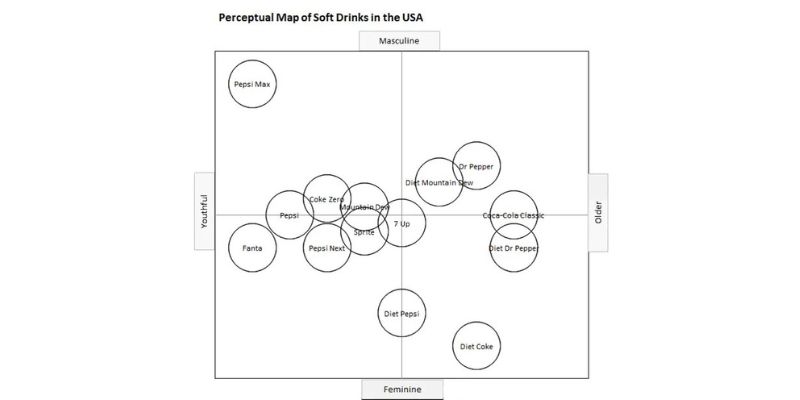What is Market Mapping?
Market mapping is a method of using a graph to visually represent the position of a company or product within a specified market based on the comparison with its competitors. The process of creating a market map involves identifying various factors, such as pricing, quality, customer perception, demand, etc., to see where the business fits in the market and how it can use it to its advantage.
Market mapping in marketing is represented with a graph having two opposite axes relevant to competitive landscape research. To determine your position within a specific market, you can choose any attributes that can be analyzed on a high-to-low scale.
The purpose of marketing mapping is to provide a company with a vivid illustration of its strengths and weaknesses compared to those of competitors. It enables the business to detect gaps in unique marketing opportunities as well as predict possible threats on the go.
Benefits of Market Mapping
Market mapping in marketing is a useful tool for growing your business. Numerous advantages of market mapping are a good reason to include this method as one of the steps in building your marketing strategy.
Have a clear vision of the competitive landscape
Not only can market mapping analysis help you detect your close competitors and their position in the market, but it will also allow you to identify the weakest players and those who pose the biggest threat to your brand.
Realize your unique selling point
Competition mapping can help you figure out your unique selling point. You will clearly see your position in the competitive landscape and thus differentiate what makes your brand and product better than that of competitors.
Reveal potential gaps in the market
Another essential advantage of market mapping is having a visual representation of potential profit opportunities. When data is presented on a graph, you can easily spot a gap in the market and fill it with your product or service.
Predict changes and tailor your market strategies
Marketing mapping allows brands to detect marketing trends and patterns easier. By doing so, you can make better future predictions about competitors’ actions and adjust your strategies to the expected changes in the market.
Recognize potential partners
A strategic partnership can bring more value and revenue, and businesses view it as a necessary strategy. Market mapping is among the effective tools to identify possible partnership brands that can help you expand your reach of products, improve customer experience, and grow your business overall.
Challenges of Market Mapping
However effective the method of market mapping is, implementing it in the marketing strategy might be tricky. The possible challenges of marketing mapping are the following:
- Examining the competitive landscape can be quite time-consuming, as you need to do scrupulous research.
- When you discover a gap in the market, it doesn’t necessarily mean that there’s a demand for it, so you need to investigate it first.
- It doesn’t provide a deep understanding of customer decision-making.
- There are no real figures or stats on the map, so it can lead to a biased opinion instead of accurate marketing and sales forecasting.
- The map consists of only two variables.
Examples of Market Mapping
To grasp the idea of market mapping in marketing better, let’s have a look at some examples focused on three factors: competitors, the product, and the target audience.
Competitors’ market map example
The first market mapping type is researching your competitors. Competitors market map allows you to quickly see the strongest players in your field and identify your position among them in the market. The key attributes to pay attention to include annual revenue, market reach, growth rate, traffic share, range of services, and pricing.
When you look at competitors on a map, you can instantly spot the gaps for your brand to enter. For example, on the map below, you can see that there’s a lack of exclusive gym services focused on a specific discipline, with only one gym trying to fill this niche. This map provides you with ideas on what niches to explore further, e.g., check the demand for exclusive yoga gym classes or luxurious nightclub gyms.
Product market map example
Another market map example revolves around investigating competitive products. For this map, you’ll need to consider pricing, product quality, product features, and customer expectations.
For example, the comparison map of mass-market clothing brands below shows the correlation between the products’ price and quality. It will help you predict customers’ expectations regarding the price and the quality in this field.
In a similar way, you can monitor consumer perception of brands in a specific market which will help you to define your product branding strategy and simplify search engine reputation management.
Audience market map example
The final market mapping example focuses on exploring the audience. You need to understand your potential customers and learn who is your best clientele. To discover who brings the most value to your brand, you should concentrate your map on the following attributes: age, gender, location, purchase frequency, income level, engagement metrics like bounce rate, click-through rate, visit duration, etc.

Having a comprehensive understanding of the target audience, including demographic data, psychographics, interests, and behavior patterns, helps to identify the most relevant and effective marketing strategies. It helps to develop the right messaging and define channels to reach the intended audience, such as social media, cold emailing, search engine advertising, influencer collaborations, or affiliate marketing.
All three market map examples can be used to serve your specific needs in examining the market. Depending on your industry, your company’s age, and your marketing objectives, you can craft a graph that will assist you with brand positioning and further strategies.
How to create a Market Map
Market mapping in marketing is an extensive strategy, as you can approach mapping in various ways. However, there are some essential steps you should follow to create an insightful market map.
- Define your objectives
First of all, you need to think of what you are trying to achieve by creating a marketing map. Decide whether you want to explore a particular market segment, develop a better pricing strategy, discover a new promising gap, etc. A clear goal will guide you through the process.
- Identify your market and competitors
Pin down your market to a narrow area that is the most relevant for your current research. Choose the most important competitors you are going to analyze or the most relevant audience you want to reach.
- Specify your unique selling point
Examine the unique selling points of your competitors and define what makes you stand out. Analyze the differences further, so your market map will help you better differentiate your brand or product from the competition.
- Choose two attributes and draw a graph
Now it’s time to choose the metrics you’ll be examining. Pick two attributes that will serve as your guide in a mapping process. Remember that these attributes should be measurable.
- Position competitors and your brand on the map
After drawing the axes, it’s time to examine competitors within the chosen attributes and place them on the market map. Choose the place that best reflects their position in the market area. Don’t forget to locate your brand with your current status on the map as well.
- Spot the positioning gaps
When you’ve positioned your brand and other brands on the graph, you can now clearly see the marketing gaps for your business.
- Repeat with other attributes
When you’re done with one map, you can go further with other attributes. The more maps you create, the easier it will be to spot potential growth opportunities.
- Keep it regular
Make market mapping a regular practice, so you can easily adjust your marketing to any upcoming changes and digital marketing trends.
Conclusion
Market mapping examples prove to be an effective tool to better understand your position and the position of your competitors in the marketplace. It’s effective for detecting new opportunities and further strategic planning. You’ll easily spot the differences between your product and brand among your competitors. And you can then use these differences to provide customers with a unique offer they’ve been waiting for.
Frequently Asked Questions
A positioning map, also known as a market map, is a graph to examine the position of your product or services in the competitive landscape. It is based on two dimensions represented by two axes with opposite attributes, such as high/low price, high/low quality, etc.
A market mapping tool is an online market map maker allowing you to quickly draw two axes with needed attributes and locate competitors on the graph by dragging their names to the map. You can also use any design tool for this purpose, like Adobe Illustrator or Canvas.
Perceptual mapping is a visual representation of how customers perceive a product/service/brand. A perceptual map differs from a positioning one, with the former focusing on customers’ perception and the latter focusing on the product/service position in the market.
There are three types of market maps based on the area of research — maps for competitors, products, and audiences.



